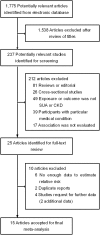Serum uric acid is associated with incident chronic kidney disease in middle-aged populations: a meta-analysis of 15 cohort studies
- PMID: 24959886
- PMCID: PMC4069173
- DOI: 10.1371/journal.pone.0100801
Serum uric acid is associated with incident chronic kidney disease in middle-aged populations: a meta-analysis of 15 cohort studies
Abstract
Background: Mounting evidence indicates that elevated serum uric acid may increase the incidence of chronic kidney disease (CKD). Our goal was to systematically evaluate longitudinal cohort studies for the association of serum uric acid levels and incident CKD.
Methods: We searched electronic databases and the reference lists of relevant articles. The primary outcome was incident CKD, which was defined as an eGFR less than 60 mL/min/1.73 m2 at the follow-up examination. Study-specific risk estimates were combined using random-effects models. The included studies were stratified into subgroups, and meta-regression analyses were performed.
Results: Fifteen unique cohorts with a total of 99,205 individuals and 3,492 incident CKD cases were included. The relative risk of CKD was 1.22 (95% CI 1.16-1.28, I2 = 65.9%) per 1 mg/dL serum uric level increment. This positive association was consistently observed in subgroups stratified according to most of the study-level characteristics. The observed positive association was more pronounced among group with a mean age <60 years (RR 1.26, 95% CI 1.21-1.31), and low-level heterogeneity was observed in the findings for this age group (I2 = 46.4%, P = 0.022). However, no association was observed among studies with a mean age≥60 years (RR 1.04, 95% CI 0.96-1.13), and no evidence of heterogeneity was evident among the studies (I2 = 0%, P = 0.409). This mean age-related difference in the association between serum uric acid levels and CKD was significant (P = 0.004). The sensitivity analysis results were consistent when the analyses were restricted to studies that controlled for proteinuria and metabolic syndrome.
Conclusions: Our meta-analysis demonstrated a positive association between serum uric acid levels and risk of CKD in middle-aged patients independent of established metabolic risk factors. Future randomized, high-quality clinical trials are warranted to determine whether lowering uric acid levels is beneficial in CKD.
Conflict of interest statement
Figures



References
-
- Jha V, Garcia-Garcia G, Iseki K, Li Z, Naicker S, et al. (2013) Chronic kidney disease: global dimension and perspectives. Lancet 382: 260–272. - PubMed
-
- Zhang L, Wang F, Wang L, Wang W, Liu B, et al. (2012) Prevalence of chronic kidney disease in China: a cross-sectional survey. Lancet 379: 815–822. - PubMed
Publication types
MeSH terms
Substances
LinkOut - more resources
Full Text Sources
Other Literature Sources
Medical
Research Materials
Miscellaneous

